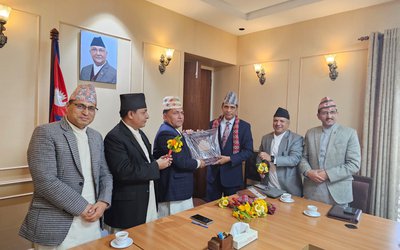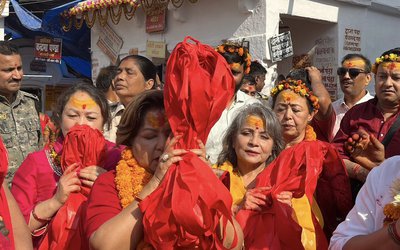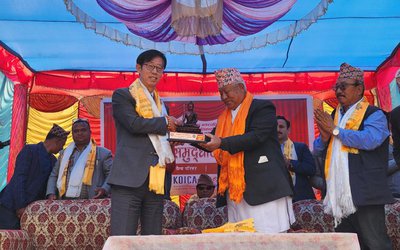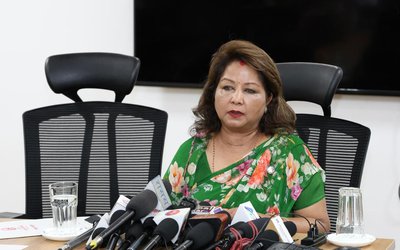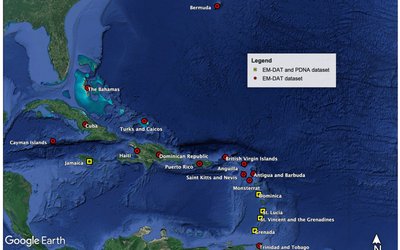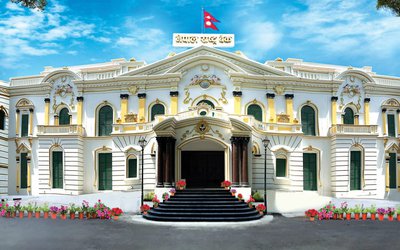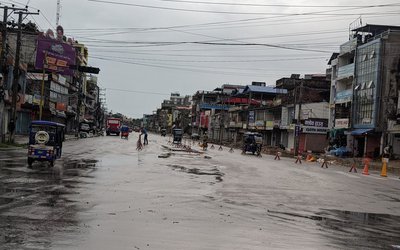
Although scientists predicted the possibility of Pokhara developing sinkholes long time ago by analyzing its fragile geology, nobody heeded to the warning as the city expansion and haphazard construction of buildings was going on.
The recent sinkhole that appeared at Thulibesi Phant of Armala in Pokhara, adjoining Pokhara Sub-Metropolitan City (PSMC), has sent shock waves to the city residents. Given the present rate of urban growth and building construction, the damage will be devastating in Pokhara in case a big earthquake jolts it or more sinkholes develop.
Looking at the geological vulnerability of Pokhara, Practical Action Nepal has been supporting the Sub-Municipality in strengthening its capacity to strictly implement the building code before any such havoc happens. The program implemented by Practical Action has changed the overall scenario in the Sub-Municipal Area.
Practical Action Nepal has been working in three areas: policy layer, community level and capacity improvement. "We are providing training to the private sector engineers and technical support personnel. We have already trained over 400 local construction workers and masons. We have also informed the house owners about the work.”
Alongside the support for Municipality's capacity building, Practical Action has also supported retrofitting school buildings, early warning system and raising awareness. "We are working to build early warning system in Niti River building check dams to provide safety to the people living in the river banks," said Gehendra Gurung, head of Climate Change and DRR at the organisation.
As Pokhara Municipality has already made the building code mandatory for new constructions since the Earthquake Day 2013, Practical Action Nepal's support has enhanced the Municipality’s institutional capability to implement it.
Annually, Pokhara municipality has been receiving over 2000 applications a year for new constructions and it is issuing permissions for 150 new constructions every month. Practical Action Nepal's support comes as a boon to the Municipality's technical department. Having no capable manpower and modalities for building codes, the Municipality used to issue permission to houses on the structure suggested by the house owners, contractors and engineers.
"The situation has changed now. After the implementation of the project by Practical Action, the Municipality now has the modality, risk mapping as well as technically well qualified technicians," said Municipal employees.
"Pokhara is a high risk area because of its geological formation. There is always a risk to construct buildings and structures," said Dinananth Bhandari, program chief of Climate Change and DRR of Practical Action.
According to a Report on Impact of Settlement Pattern, Land Use Practice and Options in High Risk Areas of Pokhara Sub‐Metropolitan City prepared by UNDP, Pokhara Sub-Metropolitan City is considered a moderately vulnerable city in terms of earthquake hazard, with the probability of intensity of VIII MMI earthquake in the region. High liquefaction susceptible zones are found in the banks and tributaries of Seti River and some patches of liquefaction susceptible zones are found in KI Singh bridge area, Laltin Bazar, and Kamal Pokhari areas.
The sinkhole collapse prone areas were identified in Chipledhunga, Mahendra Pul, Male Patan, Manaswar, Baidam, Simal Tunda, Bhagerthan and other areas which belong to the core areas of Pokhara sub-metropolitan city. “Lama Chaur, Battule Chaur, Tersa Pati and Male Patan areas were found to have high susceptibility to sinkhole hazard,"said the report.
In the past, people often ignored the building code when they constructed the houses. Now building owners, contractors and masons are very much sensitive due to the program launched by Practical Action and the Sub-municipality.
Along with encroachment of river, haphazard construction of buildings also made the area prone to sinkholes. Thus, people and authorities concerned must be aware about the geological condition of the area before conducting any construction work.
There are many places in Pokhara sub-muncipal area where people must be extra careful while carrying out construction work. It is not that entire Pokhara is in a danger zone, certain areas are unsafe. While the areas in the east of Seti River are found to be safe, the old settlement areas — Mahendra cave, Chamero cave, Davis Falls, Gupteshwor cave, New Road and Chipledhunga — need extra caution when new construction works are carried out
However, these areas have now dense human settlements with barely any space left for new buildings. Currently, there are over 4,100 houses in Chorepatan and Birauta areas of Ward -17, according to the PSMC office.
According to the PSMC office, altogether 2,854 new buildings were constructed in all the 18 wards of the sub-metropolitan city in the last fiscal year alone. Of the total constructed buildings, 490 buildings were constructed in Ward-17. It was followed by 208 buildings in Ward-8 and 186 in Ward-5. All three wards lie on weak geological structure.
As some 35 sinkholes had already formed in the Armala area east of Pokhara Municipality, this has sent an alarm bell ringing among the people. According to experts, there are chances that more such sinkholes might be formed in the coming days.
As the city is already on a high alert, the support provided by Practical Action to the municipality and vulnerable communities to prevent any disaster may pay in the future if sinkholes form or earthquake hits.
- ADB’S CHIEF ECONOMIST: Nepal Reduces Poverty
- Mar 11, 2025
- FM DR. DEUBA: A Successful Visit
- Mar 11, 2025
- MD GHISING: Target Of Personal Grudge
- Mar 09, 2025
- UPPER TRISHULI-1 HYDROPOWER: Supporting Community Development
- Feb 24, 2025
- ADB POWERING NEPAL: Five Decades Of Support
- Feb 24, 2025
